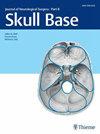鼻内窥镜入路治疗斜坡脊索瘤的结果:单中心经验
IF 0.9
4区 医学
Q3 Medicine
引用次数: 0
摘要
目的:脊索瘤是一种起源于胚胎脊索残余组织的低度恶性肿瘤。术后或最终放疗已用于加强局部控制。本研究旨在评估扩大EEA最大限度切除斜坡脊索瘤的效果,然后再进行射波刀放射手术,以观察残余或肿瘤复发。方法:回顾性分析2016年至2021年在耳鼻喉科和神经外科连续行鼻内窥镜切除的斜坡脊索瘤患者。我们纳入了所有病理证实的经鼻内窥镜入路治疗的斜坡脊索瘤患者。排除了接受外部和内窥镜联合入路或经颅手术的患者。结果:17例患者纳入本研究。多数肿瘤位于中斜坡。关于放疗(RT),大多数患者接受了术后放疗,几乎一半的患者接受了射波刀(CK)放疗。它们都没有严重的毒性(3级或更高)。3例患者死亡,死亡率为17.6%,与放射副作用无关。2年总生存率为82.4%(平均S.E. = 1.765, 95% CI = 1.505-2.024),无进展生存期(PFS)为76.5%(平均S.E. = 3.403, 95% CI = 2.791-4.016)。在我们的研究中未发现远端转移。结论:这一系列的研究表明,扩大EEA切除颅底脊索瘤后再进行射波刀放射手术是一种可接受的替代质子治疗的方法。2年总生存率为82.4%,PFS为76.5%。本文章由计算机程序翻译,如有差异,请以英文原文为准。
Outcomes of the endonasal endoscopic approach for the treatment of Clival chordomas: a single-center experience
Objective: Chordoma is a low-grade malignant tumor that originates from the remnant tissue of the embryonic notochord. Postoperative or definitive radiotherapy has been used to enhance local control. This study aims to assess the outcomes of the expanded EEA for maximal removal of clival chordomas followed by CyberKnife radiosurgery for visualized residual or tumor recurrence. Methods: A retrospective review was performed on consecutive patients with clival chordoma who underwent endoscopic endonasal resection in the Otorhinolaryngology and Neurosurgery Departments, between 2016 and 2021. We included all patients with pathologically confirmed clival chordoma who were treated using the endoscopic endonasal approach. Patients who underwent combined external and endoscopic approaches or transcranial surgery were excluded. Results: 17 patients were included in this study. Most of them had tumors located in the middle clivus. Regarding radiation therapy (RT), the majority of patients underwent postoperative RT. Almost half of them underwent CyberKnife (CK) RT. None of them had severe toxicities (grade 3 or higher). Three patients died, resulting in a mortality rate of 17.6% none on them related to radiation side effect. The 2-year overall survival was 82.4% (Mean S.E. = 1.765, 95% CI = 1.505–2.024), and the progression-free survival (PFS) was 76.5% (Mean S.E. = 3.403, 95% CI = 2.791–4.016). No distal metastasis was reported in our series. Conclusions: This series illustrates that the expanded EEA to resection of skull-base chordomas followed by CyberKnife radiosurgery is an acceptable alternative to proton therapy. The 2-year overall survival was 82.4% and PFS was 76.5%.
求助全文
通过发布文献求助,成功后即可免费获取论文全文。
去求助
来源期刊

Journal of Neurological Surgery Part B: Skull Base
CLINICAL NEUROLOGY-SURGERY
CiteScore
2.20
自引率
0.00%
发文量
516
期刊介绍:
The Journal of Neurological Surgery Part B: Skull Base (JNLS B) is a major publication from the world''s leading publisher in neurosurgery. JNLS B currently serves as the official organ of several national and international neurosurgery and skull base societies.
JNLS B is a peer-reviewed journal publishing original research, review articles, and technical notes covering all aspects of neurological surgery. The focus of JNLS B includes microsurgery as well as the latest minimally invasive techniques, such as stereotactic-guided surgery, endoscopy, and endovascular procedures. JNLS B is devoted to the techniques and procedures of skull base surgery.
 求助内容:
求助内容: 应助结果提醒方式:
应助结果提醒方式:


